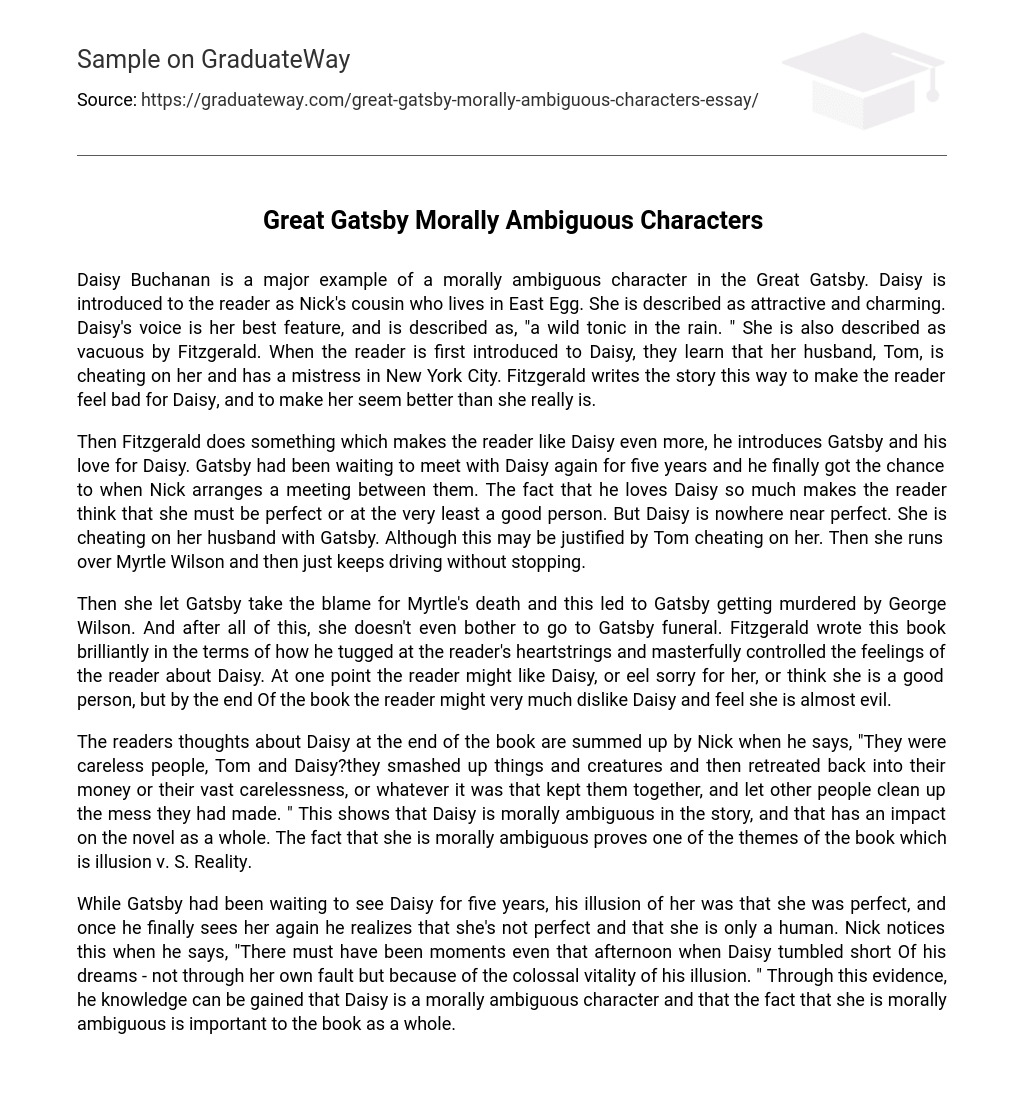Daisy Buchanan, a character in The Great Gatsby, exemplifies moral ambiguity. She is Nick’s cousin residing in East Egg, and she is described as attractive and charming. Her captivating voice is likened to a “wild tonic in the rain” while Fitzgerald also characterizes her as vacuous. Initially, it is revealed that Daisy’s husband, Tom, is unfaithful and has a mistress in New York City. Fitzgerald employs this narrative approach to evoke sympathy for Daisy and create an illusion of her being morally superior.
Fitzgerald introduces Gatsby and his love for Daisy, making the reader like her even more. Gatsby had waited for five years to meet with Daisy again, and finally got the chance when Nick arranged a meeting. Gatsby’s intense love for Daisy suggests she must be perfect, or at least a good person. However, Daisy is far from perfect – she is cheating on her husband with Gatsby, which may be justified by Tom’s infidelity. Furthermore, Daisy hits Myrtle Wilson with her car and continues driving without stopping.
Then, Daisy allows Gatsby to be blamed for Myrtle’s death, resulting in Gatsby’s murder at the hands of George Wilson. Additionally, Daisy doesn’t even bother attending Gatsby’s funeral. Fitzgerald expertly captures the reader’s emotions towards Daisy throughout the book. Initially, the reader may have positive feelings towards her or feel sympathy for her. However, by the end of the book, the reader may strongly dislike Daisy and perceive her as almost evil due to Fitzgerald’s impeccable storytelling.
The readers’ perception of Daisy at the end of the book is encapsulated by Nick’s statement, “They were careless people, Tom and Daisy – they smashed up things and creatures and then retreated back into their money or their vast carelessness, or whatever it was that kept them together, and let other people clean up the mess they had made.” This demonstrates Daisy’s moral ambiguity in the narrative, and its influence on the entire novel. The presence of her moral ambiguity reinforces one of the book’s themes, which is the contrast between illusion and reality.
During the five years Gatsby awaited seeing Daisy, he viewed her as flawless. However, upon their reunion, he discovers her imperfections and recognizes her humanity. Nick perceives this realization when he states, “There must have been moments even that afternoon when Daisy fell short Of his dreams – not through her own fault but because of the colossal vitality of his illusion.” This evidence suggests that Daisy possesses morally ambiguous traits, which hold significance for the entire story.
Another morally ambiguous character who frequently interacts with Daisy is Jay Gatsby. Gatsby, a wealthy young man residing in West Egg, is known for hosting extravagant parties. As the story’s central figure, Fitzgerald aims to present Gatsby as likable and virtuous. One way he accomplishes this is by recounting how Gatsby rescued Dan Cody from a potential boat crash.
Fitzgerald demonstrates the various ways in which Gatsby can be perceived. One approach is through Gatsby’s dedication to amassing wealth in order to marry his beloved Daisy Buchanan, which is seen as a noble pursuit. This is why he is revered as the Great Gatsby, as he pursued such a noble cause – love. However, a complication arises when it becomes necessary for Daisy to cheat on her husband, Tom, in order to be with Gatsby. This unethical behavior tarnishes Gatsby’s virtuous image. Additionally, Gatsby’s fortune is acquired through illegal activities like bootlegging, further reinforcing his questionable character. On the other hand, Gatsby can be seen as good due to his willingness to take responsibility for Myrtle’s death. These contrasting examples demonstrate Gatsby’s moral ambiguity. This ambiguity is crucial to the overarching theme of the story, highlighting the sustaining power of hope. Gatsby’s unwavering hope of being with Daisy compelled him to resort to unsavory actions, ultimately reflecting his unwavering determination to achieve his noble goal. This hope also led him to engage in behaviors he would not have considered otherwise, such as bootlegging and aiding infidelity.





